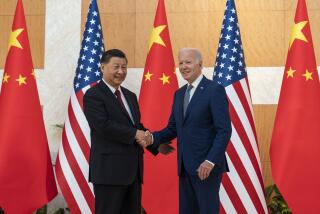The Invasion by Foreign Investors : It’s Not All Bad, but Reporting Requirements Are Inadequate
Paul Krugman, an economist at the Massachusetts Institute of Technology, predicted not long ago that “the political issue of the 1990s isn’t going to be imports; it’s going to be the foreign invasion of the United States.” The professor was talking about the rising tide of foreign investment in this country, and he could be right.
Although it has not received much attention, the trade bill passed by the House would require foreign investors to report any major holding in U.S. business or real estate, or in large blocks of corporate securities. The Senate-passed trade bill would provide for review of foreign acquisitions of U.S. businesses from the standpoint of effect on national security.
Rep. John Bryant (D-Tex.), sponsor of the House measure, insists that he doesn’t necessarily oppose foreign investment. But, as he told the Wall Street Journal, “America has been selling off its family jewels to pay for a night on the town, and we don’t know enough about the proud new owners.”
Because of inadequate reporting requirements, the extent of foreign investment in the United States cannot be pinned down with precision. The total is frequently put at $1.3 trillion, of which $200 billion or so represents direct investments in U.S. business or financial institutions. If you were to require every foreign-owned enterprise to fly the national flag of its owners for a day, the result would surprise most Americans. Carnation Co. is Swiss. Doubleday, RCA Records, Celanese and General Tire are all German. Zale Corp., the giant jewelry retailer, is Canadian. Purina Mills, Smith and Wesson, and J. Walter Thompson advertising agency are British. The list goes on.
Because the Japanese were late starters, their U.S. investments are not much more than one-tenth as large as those of the Europeans. But the Japanese are coming on strong. Direct Japanese investment in the United States has more than tripled, to more than $25 billion, in just five years. Already Japanese banks have the largest foreign presence in the United States; they are especially strong in California. The Japanese also are plunging into the commercial real-estate market. Their holdings include the ARCO Plaza and Chase Plaza in Los Angeles, Essex House, the Exxon Building and Capital Cities/ABC headquarters in New York, plus major structures in Boston, Washington, San Francisco, Honolulu and other cities.
About 435 U.S. manufacturers in such disparate fields as auto assembly, chemicals, electronics, auto parts, textile equipment and steel products are owned wholly or partly by the Japanese. And the invasion continues.
In some sectors of the U.S. economy, foreign ownership has reached major proportions. To cite but two examples: Four of the top 10 chemical companies and more than half the cement industry are foreign-owned. All this is happening because of the huge U.S. trade deficit--which reflects a lack of American competitiveness, made worse in some cases by predatory trading practices by other nations--and the related decrease in the dollar’s value relative to other major currencies.
When Japan and West Germany earn big trade surpluses, they are not going to stick the money under the mattress. They are going to put it to work. That means foreign loans and investments. Japan’s total external investments already exceed those of the oil-producing nations of the Middle East at their peak, and much of this money is being channeled to American government and business. Last year Japanese investors bought 35% of all new long-term Treasury issues, thus financing a substantial portion of the U.S. budget deficit. As time goes on, the Japanese are increasingly attracted by direct investments in U.S. real estate and manufacturing. Several factors are involved, but the most important is the desire to buy guaranteed access to the huge American market--and to do it at bargain-basement prices. By making foreign goods more expensive in America and U.S. products cheaper in other countries, the plummeting value of the dollar during the last two years has helped make American firms more competitive. But the cheap dollar also enables foreign interests to buy U.S. companies at a discount.
Whether we should worry about mushrooming foreign investment or welcome it as a godsend is a matter of dispute. On the plus side, Japanese purchases of Treasury offerings have unquestionably held U.S. interest rates lower than they would otherwise be. Japanese-owned enterprises in this country employ 170,000 Americans. Because of their efficiency and managerial superiority, they also provide a healthy competitive spur to American-owned companies.
Surely it is better for foreigners to export their money here, creating American jobs, than to export goods that take away American jobs. But there is a downside. Complaints are heard that when the Japanese build a plant here they tend to bring their own financing, construction companies and components, thereby minimizing the favorable effect on the U.S. economy.
The eventual profits will flow out of this country to the foreign owners, thereby helping to feed their research and development and to perpetuate whatever competitive edge they have. The Japanese, especially, have shown more interest in acquiring leading-edge American technology than in sharing their best technology with us.
Finally, just as other governments worry that American-run companies in their countries sometimes make decisions that serve U.S. national interests to the detriment of their own, we are entitled to the same concern about foreign-owned companies here. And, since other nations have long had systematic review procedures to ensure that acquisitions by U.S. companies serve their interests as well as ours, there is no reason we should not have them, too.
Kent Calder, a Japan scholar at Princeton, says that by the year 2000 these kinds of questions will fade into irrelevance, that America and Japan “will be close to being one economy.” Maybe. But that shouldn’t happen without a conscious decision by the American people.
More to Read
Inside the business of entertainment
The Wide Shot brings you news, analysis and insights on everything from streaming wars to production — and what it all means for the future.
You may occasionally receive promotional content from the Los Angeles Times.










